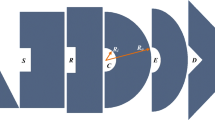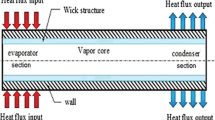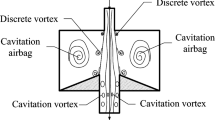Abstract
In this study, a modelling procedure is followed to simultaneously optimize the heat transfer and entropy generation performance in the impinging jet flow on a convex surface. For this optimization study, numerical results of laminar nanofluid flow (Al2O3/water) having two different particle shape (blade and cylindrical) were used as inputs and optimum Nusselt number and total entropy generation parameters were obtained by using RSM-based multi-objective grey relation analysis. Different nanofluid volume fractions, target distance/nozzle diameter ratio (H/B) and Reynolds numbers were evaluated for the analysis. Each control variable has three levels except for the particle shape (blade and cylindrical). In total, forty CFD analyses have been performed based on these variables and the findings obtained by the RSM-based multi-objective grey relation analysis reveal that geometric differences and nanofluid properties have a considerable impact on the performance of jet impingement cooling. The results show that the H/B ratio has the greatest impact on heat transfer enhancement and entropy generation improvement on convex surface at laminar flow conditions. As a result of the optimization, the highest Nu number and the lowest entropy generation obtained by grey relation analysis were found to be 4.383 and 9.06 × 10–4 kj/kg K, respectively, for blade-shaped alumina nanofluid at H/B = 2.







Similar content being viewed by others
Data availability
The datasets generated during and/or analysed during the current study are available from the corresponding author on reasonable request.
Abbreviations
- Be :
-
Bejan number [-]
- C P :
-
Specific heat [J/kgK]
- D h :
-
Hydraulic diameter [m]
- f :
-
Darcy friction factor [-]
- h :
-
Convective heat transfer coefficient [W/m2K]
- k :
-
Conductive heat transfer coefficient [W/mK]
- \(\dot{m}\) :
-
Mass flow rate [kg/s]
- Nu :
-
Nusselt number
- P :
-
Pressure [Pa]
- Pr :
-
Prandtl number [Pa]
- \(q^{\prime \prime}\) :
-
Heat flux [W/m2]
- Re :
-
Reynolds number
- \(\dot{S}^{\prime}_{gen}\) :
-
Entropy generation rate per unit length [W/mK]
- T :
-
Temperature [K]
- V :
-
Velocity vector
- \(\mu\) :
-
Dynamic viscosity [Pas]
- \(\rho\) :
-
Density [kg/m3]
- \(\varphi\) :
-
Nanoparticle volume fraction [-]
- b:
-
Bulk
- bf:
-
Base fluid
- gen:
-
Generation
- hnf:
-
Hybrid nanofluid
- w:
-
Wall
References
Kursuncu B, Biyik YE (2021) Optimization of cutting parameters with Taguchi and grey relational analysis methods in MQL-assisted face milling of AISI O2 steel. J Cent South Univ. https://doi.org/10.1007/s11771-021-4590-4
Karimifard S, Alavi Moghaddam MR (2018) Application of response surface methodology in physicochemical removal of dyes from wastewater: a critical review. Sci Total Environ 640–641:772–797. https://doi.org/10.1016/J.SCITOTENV.2018.05.355
Ferreira SLC, Bruns RE, Ferreira HS et al (2007) Box-Behnken design: an alternative for the optimization of analytical methods. Anal Chim Acta 597:179–186
Behbahani M, Moghaddam MRA, Arami M (2011) Techno-economical evaluation of fluoride removal by electrocoagulation process: optimization through response surface methodology. Desalination 271:209–218
Manca O, Ricci D, Nardini S, Di Lorenzo G (2016) Thermal and fluid dynamic behaviors of confined laminar impinging slot jets with nanofluids. Int Commun Heat Mass Transfer 70:15–26. https://doi.org/10.1016/j.icheatmasstransfer.2015.11.010
Kim YH, Lee DH, Han SH (2017) Investigation of impingement surface geometry effects on heat transfer in a laminar confined impinging slot jet. Int J Heat Mass Transf 115:347–353. https://doi.org/10.1016/j.ijheatmasstransfer.2017.08.070
Rajabi Zargarabadi M, Rezaei E, Yousefi-Lafouraki B (2018) Numerical analysis of turbulent flow and heat transfer of sinusoidal pulsed jet impinging on an asymmetrical concave surface. Appl Therm Eng 128:578–585. https://doi.org/10.1016/j.applthermaleng.2017.09.059
Li Y, Li B, Qi F, Cheung SCP (2018) Flow and heat transfer of parallel multiple jets obliquely impinging on a flat surface. Appl Therm Eng 133:588–603. https://doi.org/10.1016/j.applthermaleng.2018.01.064
Wienand J, Riedelsheimer A, Weigand B (2017) Numerical study of a turbulent impinging jet for different jet-to-plate distances using two-equation turbulence models. Eur J Mech B/Fluids 61:210–217. https://doi.org/10.1016/j.euromechflu.2016.09.008
Bentarzi F, Mataoui A, Rebay M (2019) Effect of inclination of twin impinging turbulent jets on flow and heat transfer characteristics. Int J Therm Sci 137:490–499. https://doi.org/10.1016/j.ijthermalsci.2018.12.021
Zunaid M, Cho HM, Husain A et al (2018) Computational analysis of liquid jet impingement microchannel cooling. Mater Today Proc 5:27877–27883. https://doi.org/10.1016/j.matpr.2018.10.026
Cademartori S, Cravero C, Marini M, Marsano D (2021) CFD simulation of the slot jet impingement heat transfer process and application to a temperature control system for galvanizing line of metal band. Appl Sci 11:1–23. https://doi.org/10.3390/app11031149
Issac J, Singh D, Kango S (2020) Experimental and numerical investigation of heat transfer characteristics of jet impingement on a flat plate. Heat and Mass Transfer 56:531–546. https://doi.org/10.1007/s00231-019-02724-9
Huang H, Sun T, Zhang G et al (2018) Modeling and computation of turbulent slot jet impingement heat transfer using RANS method with special emphasis on the developed SST turbulence model. Int J Heat Mass Transf 126:589–602. https://doi.org/10.1016/j.ijheatmasstransfer.2018.05.121
Yang B, Chang S, Wu H et al (2017) Experimental and numerical investigation of heat transfer in an array of impingement jets on a concave surface. Appl Therm Eng 127:473–483. https://doi.org/10.1016/j.applthermaleng.2017.07.190
Celik N, Pusat G, Turgut E (2018) Application of Taguchi method and grey relational analysis on a turbulated heat exchanger. Int J Therm Sci 124:85–97. https://doi.org/10.1016/j.ijthermalsci.2017.10.007
Fu J, Cai J (2020) Study of heat transfer and the hydrodynamic performance of gas-solid heat transfer in a vertical sinter cooling bed using the CFD-taguchi-grey relational analysis method. Energies (Basel). https://doi.org/10.3390/en13092225
Sridharan M (2022) Performance optimization of counter flow double pipe heat exchanger using grey relational analysis. Int J Ambient Energ 43:5318–5326. https://doi.org/10.1080/01430750.2021.1946148
Garud KS, Lee MY (2023) Grey relational based Taguchi analysis on heat transfer performances of direct oil spray cooling system for electric vehicle driving motor. Int J Heat Mass Transf. https://doi.org/10.1016/j.ijheatmasstransfer.2022.123596
Chamoli S, Yu P, Kumar A (2016) Multi-response optimization of geometric and flow parameters in a heat exchanger tube with perforated disk inserts by Taguchi grey relational analysis. Appl Therm Eng 103:1339–1350. https://doi.org/10.1016/j.applthermaleng.2016.04.166
Çinici OK, Canlı ME, Çakıroğlu R, Acır A (2022) Optimization of melting time of solar thermal energy storage unit containing spring type heat transfer enhancer by Taguchi based grey relational analysis. J Energ Storage. https://doi.org/10.1016/j.est.2021.103671
Razak Kaladgi A, Afzal A, Manokar AM et al (2021) Integrated Taguchi-GRA-RSM optimization and ANN modelling of thermal performance of zinc oxide nanofluids in an automobile radiator. Case Stud Therm Eng. https://doi.org/10.1016/j.csite.2021.101068
Dagdevir T (2022) Multi-objective optimization of geometrical parameters of dimples on a dimpled heat exchanger tube by Taguchi based Grey relation analysis and response surface method. Int J Therm Sci. https://doi.org/10.1016/j.ijthermalsci.2021.107365
Barroso-Maldonado JM, Belman-Flores JM, Ledesma S, Aceves SM (2018) Prediction of heat transfer coefficients for forced convective boiling of N2-hydrocarbon mixtures at cryogenic conditions using artificial neural networks. Cryogenics (Guildf) 92:60–70. https://doi.org/10.1016/j.cryogenics.2018.04.005
Mahanthesh B, Shehzad SA, Mackolil J, Shashikumar NS (2021) Heat transfer optimization of hybrid nanomaterial using modified Buongiorno model: a sensitivity analysis. Int J Heat Mass Transf. https://doi.org/10.1016/j.ijheatmasstransfer.2021.121081
Kareem ZS, Balla HH, Abdulwahid AF (2019) Heat transfer enhancement in single circular impingement jet by CuO-water nanofluid. Case Stud Therm Eng 15:100508. https://doi.org/10.1016/j.csite.2019.100508
Sun B, Zhang Y, Yang D, Li H (2019) Experimental study on heat transfer characteristics of hybrid nanofluid impinging jets. Appl Therm Eng 151:556–566. https://doi.org/10.1016/j.applthermaleng.2019.01.111
Vanaki SM, Mohammed HA, Abdollahi A, Wahid MA (2014) Effect of nanoparticle shapes on the heat transfer enhancement in a wavy channel with different phase shifts. J Mol Liq 196:32–42. https://doi.org/10.1016/j.molliq.2014.03.001
Timofeeva EV, Routbort JL, Singh D (2009) Particle shape effects on thermophysical properties of alumina nanofluids. J Appl Phys. https://doi.org/10.1063/1.3155999
Es HA, Hamzacebi C, Firat SUO (2018) GRA-TRI: a multicriteria decision aid classification method based on grey relational analysis. J Grey Syst 30:1–12
Mia M, Dhar NR (2016) Prediction of surface roughness in hard turning under high pressure coolant using artificial neural network. Measurement 92:464–474. https://doi.org/10.1016/j.measurement.2016.06.048
Mia M, Razi MH, Ahmad I et al (2017) Effect of time-controlled MQL pulsing on surface roughness in hard turning by statistical analysis and artificial neural network. Int J Adv Manuf Technol 91:3211–3223. https://doi.org/10.1007/s00170-016-9978-1
Ustaoglu A, Kursuncu B, Alptekin M, Gok MS (2020) Performance optimization and parametric evaluation of the cascade vapor compression refrigeration cycle using Taguchi and ANOVA methods. Appl Therm Eng 180:115816. https://doi.org/10.1016/j.applthermaleng.2020.115816
Maruda RW, Krolczyk GM, Nieslony P et al (2016) The influence of the cooling conditions on the cutting tool wear and the chip formation mechanism. J Manuf Process 24:107–115. https://doi.org/10.1016/j.jmapro.2016.08.006
Varghese V, Annamalai K, Kumar KS (2014) Optimisation of machining parameters for high feed end milling on inconel 718 super alloy. Appl Mech Mater 592–594:584–590. https://doi.org/10.4028/www.scientific.net/AMM.592-594.584
Greco CS, Paolillo G, Ianiro A et al (2018) Effects of the stroke length and nozzle-to-plate distance on synthetic jet impingement heat transfer. Int J Heat Mass Transf 117:1019–1031. https://doi.org/10.1016/j.ijheatmasstransfer.2017.09.118
Naphon P, Nakharintr L, Wiriyasart S (2018) Continuous nanofluids jet impingement heat transfer and flow in a micro-channel heat sink. Int J Heat Mass Transf 126:924–932. https://doi.org/10.1016/j.ijheatmasstransfer.2018.05.101
Kaya H, Arslan K, Eltugral N (2018) Experimental investigation of thermal performance of an evacuated U-tube solar collector with ZnO/Etylene glycol-pure water nanofluids. Renew Energy 122:329–338. https://doi.org/10.1016/j.renene.2018.01.115
Kaya H, Arslan K (2019) Numerical investigation of efficiency and economic analysis of an evacuated U-tube solar collector with different nanofluids. Heat and Mass Transfer 55:581–593. https://doi.org/10.1007/s00231-018-2442-z
Moosavi M, Goharshadi EK, Youssefi A (2010) Fabrication, characterization, and measurement of some physicochemical properties of ZnO nanofluids. Int J Heat Fluid Flow 31:599–605. https://doi.org/10.1016/j.ijheatfluidflow.2010.01.011
Li Y, Fernández-Seara J, Du K et al (2016) Experimental investigation on heat transfer and pressure drop of ZnO/ethylene glycol-water nanofluids in transition flow. Appl Therm Eng 93:537–548. https://doi.org/10.1016/j.applthermaleng.2015.09.020
Vajjha RS, Das DK (2009) Experimental determination of thermal conductivity of three nanofluids and development of new correlations. Int J Heat Mass Transf 52:4675–4682. https://doi.org/10.1016/j.ijheatmasstransfer.2009.06.027
Author information
Authors and Affiliations
Corresponding author
Ethics declarations
Conflict of interest
The authors state that there is no conflict of interest.
Additional information
Publisher's Note
Springer Nature remains neutral with regard to jurisdictional claims in published maps and institutional affiliations.
Rights and permissions
Springer Nature or its licensor (e.g. a society or other partner) holds exclusive rights to this article under a publishing agreement with the author(s) or other rightsholder(s); author self-archiving of the accepted manuscript version of this article is solely governed by the terms of such publishing agreement and applicable law.
About this article
Cite this article
Akgül, V., Kurşuncu, B. & Kaya, H. Response surface methodology-based multi-objective grey relation optimization for impinging jet cooling with Al2O3/water nanofluid on a curved surface. Neural Comput & Applic 35, 13999–14012 (2023). https://doi.org/10.1007/s00521-023-08357-8
Received:
Accepted:
Published:
Issue Date:
DOI: https://doi.org/10.1007/s00521-023-08357-8




